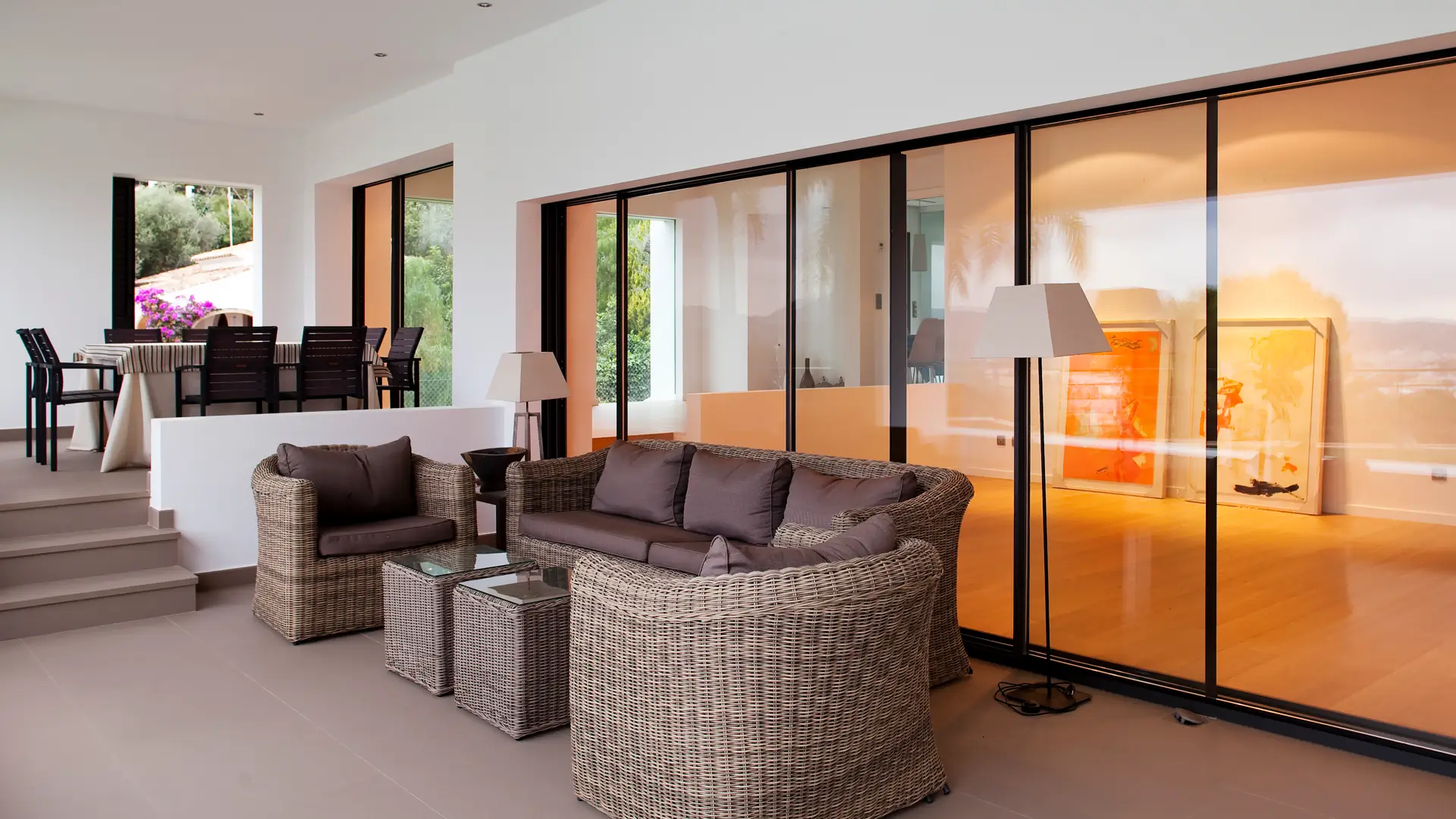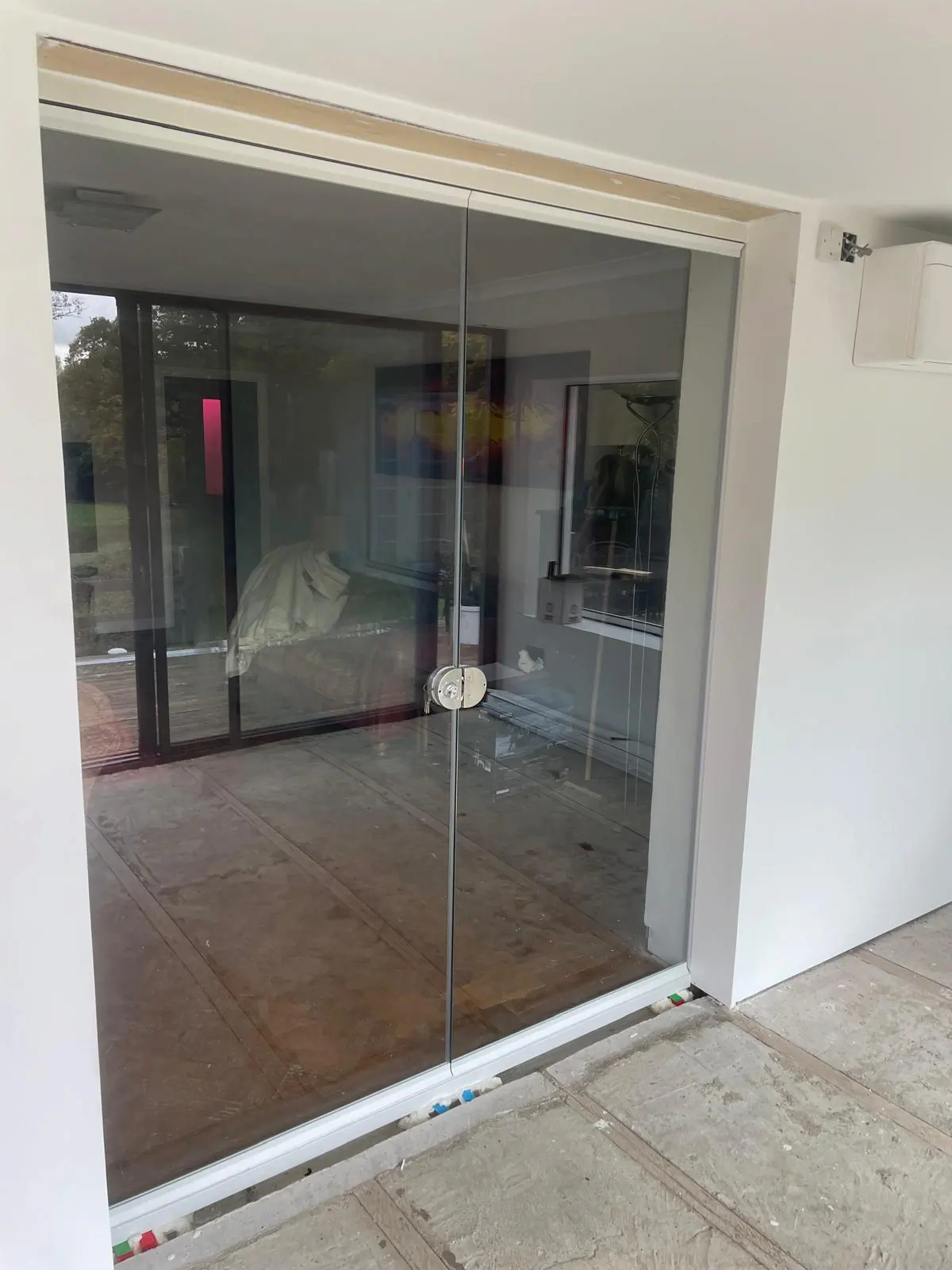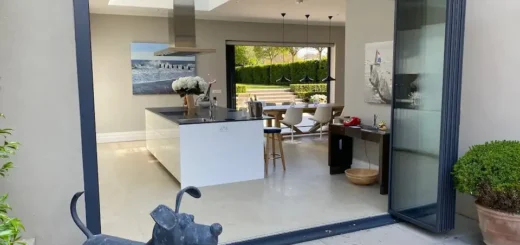Internal Room Divider Doors Guide: Types and Styles
Table of Contents
Internal room divider doors let you split your home into distinct zones while keeping the option to open up spaces when needed. Built to fold, slide, or pivot, these doors blend practicality with style, giving you control over how you use your living space.
Types of Internal Room Divider Doors
Different door systems suit different spaces and needs. The right choice depends on your room layout, available space, and how you plan to use the divided areas.
Bifold Doors
Unlike traditional hinged doors, bifold doors (also known as accordion doors or glass concertina doors) work particularly well for wider openings where you might want to separate a dining room from a living area. The panels fold flat against the wall, taking up minimal space when open.
In smaller homes, concertina doors prove especially useful. Their stack depth when open is typically just a fraction of the total door width, making them perfect for spaces where every centimetre counts. The folding mechanism allows smooth operation with minimal effort, while the multi-panel design creates an interesting visual feature even when closed.
Sliding Doors
Sliding interior doors move parallel to your wall on a single track, offering a space-saving alternative to hinged options. The simple sliding motion requires no clearance arc, making these doors ideal for tight spaces or areas with furniture placed close to the doorway. Modern sliding systems use precision rollers that ensure quiet, reliable operation year after year.

Glass panels in sliding doors help maintain brightness throughout your home. When closed, they act as a subtle barrier while allowing natural light to flow between spaces. The track system can be mounted either on the ceiling or floor, depending on your room’s structure and your preferences.
Frameless Glass Doors
Pure glass panels create flexible living spaces without visual barriers. The minimal hardware and absence of frames make these doors almost invisible when clean, yet they effectively divide rooms when needed. Toughened safety glass ensures durability and peace of mind, while various glass finishes offer different levels of privacy.
A tracking system hidden in the ceiling keeps the look clean and modern. The glass panels can stack to one side or split to both ends of the track, depending on your room layout and preferences.
Slide and Turn Doors
These adaptable systems combine sliding and pivoting movements, offering ultimate flexibility in how you arrange your space. Each panel moves independently along the track and can rotate 90 degrees, allowing you to create partial openings or remove the barrier completely. The panels stack neatly against one another when fully opened, sitting perpendicular to the track.
French Doors
Classic French doors swing open from a central point, bringing traditional charm to period properties. Their hinged design offers a wide opening when both doors are pushed back. Glass panels within the frame maintain visual connection between spaces while providing effective sound reduction when closed.
Designing with Internal Room Divider Doors
Creating separate zones in your home requires careful planning and an eye for detail. Internal room divider doors offer countless design possibilities, from classic wood-framed panels to modern glass doors that virtually disappear when opened.
Home Office Layouts
Working from home demands privacy and quiet. Internal room divider doors between your office and living areas provide the separation needed for productive work while keeping you connected to the rest of the house.
Remote workers often struggle with background noise and visual distractions. The right internal room divider doors can solve both issues – frosted glass panels offer privacy without blocking light, while solid panels with proper seals dampen sound effectively. Double-glazed glass room dividers provide extra sound insulation, perfect for video calls or intense focus work.
Your office space might need different levels of privacy throughout the day. Internal glass sliding doors room dividers adapt to various situations – fully open for family time, partially closed for casual work, or completely shut for important meetings. Multiple track systems allow you to divide larger rooms into distinct work zones, each with its own access point.

Kitchen and Living Spaces
Open-plan living sometimes needs boundaries. Internal room divider doors let you control cooking smells and noise without permanently splitting your space. The huge range of styles available means you can match your doors to existing kitchen features, whether that’s industrial-style black frames or minimalist clear glass.
When entertaining guests, internal folding doors prove their worth. Hosting dinner parties? Keep cooking mess hidden while staying part of the conversation. These doors create natural breaks between cooking and dining zones while maintaining the social aspect of open-plan living.
Children’s Rooms
Kids’ needs change quickly, and internal room divider doors adapt just as fast. Today’s playroom might become tomorrow’s study space, making flexible living spaces essential. Sturdy glass panels withstand daily use while letting parents keep an eye on younger children.
Using internal room divider doors in children’s areas requires special attention to safety features, including:
- Soft-close mechanisms
- Finger-safe hinges
- Toughened safety glass
- Child-proof locks
- Anti-trap devices
Storage Areas
Smart storage design often incorporates internal room divider doors as hiding spots for clutter. These doors turn awkward corners into useful storage nooks, concealing everything from coat collections to hobby equipment. The interplay between internal glass room dividers and clever storage solutions creates spaces that work harder without looking cluttered.
Lighting Integration
Proper lighting makes internal room divider doors shine – literally. Modern doors interact beautifully with both natural and artificial light sources. Strip lighting along tracks or recessed ceiling spots create atmosphere while improving visibility. Internal room divider doors with sandblasted or acid-etched panels diffuse light evenly throughout connected spaces.
The way natural light moves through your home affects where you place internal room divider doors. South-facing rooms might benefit from UV-protected glass panels, while north-facing spaces work well with clear glass to make the most of available light. Pattern films or decorative glass add interest while managing light levels between divided areas.
Materials and Hardware
Glass Types
Modern internal sliding doors often feature toughened safety glass, which breaks into small, rounded pieces if damaged. When choosing internal room divider doors for busy areas, double-glazed panels provide better sound insulation and increased durability. Internal glass room dividers often come in various finishes – clear glass suits bright spaces, while textured or sandblasted options add privacy.
Glass panes range from simple clear panels to intricate designs. Internal room divider doors might use laminated glass for extra security, or acoustic glass to reduce noise between spaces. Some interior room divider doors incorporate switchable glass that turns opaque at the touch of a button, though these systems cost more than standard options.
Door Frames
A wide range of frame materials shapes how internal room divider doors look and perform. Aluminium frames offer strength without bulk, while timber brings warmth and character. Internal bi-fold doors often use composite frames that resist warping and need little maintenance.

Minimalistic frames keep the focus on the glass, creating clean lines in modern living spaces. Internal room divider doors with powder-coated aluminium frames resist scratches and chips, making them practical for high-traffic areas. The frame finish affects both appearance and durability – anodised aluminium withstands daily use, while painted wood needs occasional touch-ups.
Operating Systems
Frame options influence how internal room divider doors move and feel. Top-hung systems glide smoothly but need strong ceiling support, while bottom-rolling designs spread weight across the floor. Internal glass room dividers use precision-engineered rollers that ensure reliable operation for years.
Quality hardware makes internal room divider doors easier to use. Modern internal doors feature soft-close dampers that prevent slamming, while multi-point locking systems keep panels securely closed. The tracking system’s design affects how smoothly doors operate – premium systems use bearings rated for thousands of cycles.
Installation Requirements
Proper fitting of internal room divider doors demands precise measurements and skilled installation. Load-bearing calculations determine whether your ceiling can support top-hung systems. Bottom-mounted internal room divider doors need level floors and may require additional support beneath the track.
The choice between surface-mounted or recessed tracks impacts both looks and practicality. Surface tracks make installation simpler but stand proud of walls and floors. Internal room divider doors with recessed tracks create cleaner lines but need more extensive preparation work. Professional installation ensures proper alignment, smooth operation, and long-term reliability.
Styles of Internal Room Divider Doors
Your home’s character guides style choices for dividing spaces. Clean lines suit contemporary homes, while ornate details match period properties.

Modern Glass
Glass room divider doors with slim aluminium frames bring fresh, open feels to spaces. Black frames create striking contrasts against white walls, while metallic finishes add subtle shimmer.
Internal room divider doors in contemporary settings often feature edge-to-edge glass with barely visible fixings.
Single glazed doors work well in modern homes where sound insulation isn’t the main priority. Interior glass doors reflect and refract light, making spaces feel bigger and brighter, whilst simplistic handle designs and minimal hardware help keep the focus on clean lines and pure materials.
Monochrome colour schemes help internal room dividers stand out as design features. Grey-tinted glass reduces glare while maintaining transparency, and bronze-tinted panels add warmth without compromising light flow. Internal bifolds with dark frames create bold geometric patterns when closed.
Period Features
Traditional homes need sympathetic design touches. Internal room divider doors with Georgian bars or leaded designs echo original features while improving how spaces work. Wood frames painted to match existing joinery create cohesive looks throughout period properties.
Panelled designs bring character to interior room dividers in older homes. Quarter-light glazing patterns reference traditional internal door styles, while modern glass and hardware improve usability. Brass or chrome fittings add subtle luxury that works in both classic and updated interiors.
Industrial Design
Raw materials and exposed mechanics define industrial-style spaces. Internal room divider doors with visible rolling hardware and metal frames suit warehouse conversions and loft apartments. Crittall-style designs divide spaces while maintaining industrial authenticity.
Steel frames painted in matte black create strong visual statements. Internal glass room dividers with grid patterns echo factory windows, bringing authentic industrial character to modern spaces. Exposed fixings and robust handles emphasise utility without sacrificing style.
Colour and Finish Options
Powder-coated frames come in countless colours beyond standard white and black. Internal room divider doors can match or contrast with your walls, creating subtle or striking effects. Metallic finishes like brushed steel or copper add depth without overpowering other design elements.
Specialist glass finishes offer more than just clear views. Acid-etched patterns provide privacy while letting light through, and gradient effects create subtle transitions between spaces. Fluted or reeded glass adds texture and interest while obscuring direct views.
Planning and Installation
Success starts with accurate measurements and detailed preparation. Every opening needs thorough assessment to identify potential issues before work begins.
Proper groundwork ensures they fit perfectly first time. Internal room divider doors need precise measurements – being off by even a few millimetres can cause problems with operation. Wall, floor, and ceiling levels affect how well doors work, so checking these early prevents headaches later.
Required Space
Track systems need specific clearances to work properly. Interior glass room dividers typically need space above for hardware and below for smooth running. The stack space where doors gather when open varies by system – bifolds need roughly 10% of the total width, while sliding doors need about half their width.
Different opening mechanisms need different amounts of room. Internal room divider doors that pivot need space to swing, while sliding systems just need parallel wall space. Floor-mounted tracks might need extra depth for proper support, affecting floor finishes and door thresholds.
Sound Insulation
Gaps let noise travel between spaces. Double-glazed panels in internal glass room dividers cut noise better than single glass, while proper seals stop sound sneaking around edges. Different glass types and thicknesses affect how much noise carries through.
Sound waves find weak points quickly. Internal room divider doors need proper installation to maintain acoustic properties. Rubber gaskets between glass and frame help, while brush seals along tracks reduce noise leak without affecting smooth operation.
Weight and Structure
Heavy glass needs proper support. Load calculations determine whether your ceiling can handle top-hung systems or if bottom-rolling options work better. Internal room divider doors put stress on surrounding walls, so structural checks matter.
Track positioning affects how doors work long-term. Top tracks need fixing to solid structure, not just plasterboard. Bottom tracks spread weight across the floor, but might need extra support underneath to prevent sagging or movement.
Hardware Choice
Quality components keep doors working smoothly. Ball-bearing rollers last longer than basic wheels, while precision-made tracks reduce noise and wear. Internal room divider doors with good hardware feel solid and reliable, making daily use a pleasure rather than a chore.
The right handles improve usability. Flush pulls suit sliding systems, while lever handles work well on pivot doors. Different locking options suit different needs – simple latches for most spaces, security locks for sensitive areas like home offices.
Internal Room Divider Doors FAQ
What are internal room dividers?
Internal room dividers offer a way to split spaces without permanent walls. They range from simple sliding panels to complex multi-door systems that fold and pivot, giving you control over how your space works at different times of day.
Do glass room dividers block sound effectively in offices?
When used in offices, glass office partitions with double glazing and proper seals can reduce noise by up to around 45 decibels. High-quality acoustic glass and professional installation make a marked difference to sound reduction. Most standard single-glazed options only offer basic noise control, though this suits many home situations.
What’s the difference between sliding and bifold room dividers?
Internal glass room divider doors that slide need about half their width in parallel wall space, moving smoothly along a single track. Bifolds fold like a concertina and need only 10-15% of their total width for stacking, but they use more complex tracking systems and hardware. The choice often comes down to available space and how you plan to use the doors daily.
Are internal room dividers suitable for period homes?
Internal room dividers work well in older properties when styled appropriately. Traditional panel designs, or Georgian bars, complement period features while adding modern practicality.
Many period homes already have large openings between rooms that suit divider installation. Choose hardware that matches existing door furniture for a cohesive look across your space.
Can I match existing door styles?
Internal room dividers come in countless frame designs and finishes to suit your current doors. Panel layouts, glazing bars, and hardware can all be customised to create visual harmony throughout your home.
Can internal doors be fitted on uneven floors?
Fitting internal glass room divider doors on uneven floors requires careful planning and possibly floor preparation. Most systems can handle slight variations using adjustable hardware and special tracks, but significant unevenness might need levelling work before installation.
Can I have different frame colours on each side?
Dual-colour internal glass room divider doors let you match different colour schemes in adjoining rooms. While this option costs more than single-colour frames, it offers greater design flexibility and helps each space maintain its own character.
Can internal doors be fitted in conservatories?
Internal glass room divider doors work particularly well in conservatories, helping manage temperature and create usable year-round spaces. Professional installation ensures proper fixing to conservatory frames and appropriate glass specifications for temperature fluctuations. The right system can help regulate heat while maintaining views of your garden.
About SunSeeker Doors
With over 20 years of experience, SunSeeker Doors remains at the forefront of door design with our quality-tested patio doors and related products, including the bespoke UltraSlim aluminium slide and pivot door system, Frameless Glass Doors, and Slimline Sliding Glass Doors. All of our doors are suitable for both internal and external use.
To request a free quotation, please use our online form. You may also contact 01582 492730, or email info@sunseekerdoors.co.uk if you have any questions.




